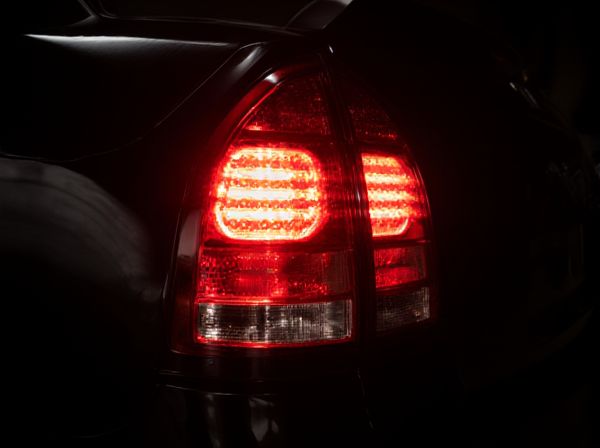
Photo illustration: Fiber Optic vs Conventional Taillight
Fiber optic taillights offer enhanced brightness and faster response times compared to conventional taillights, resulting in improved visibility and safety. Their lightweight and flexible design allows for more creative and efficient vehicle lighting configurations. Your choice between fiber optic and conventional taillights impacts both vehicle aesthetics and overall performance on the road.
Table of Comparison
| Feature | Fiber Optic Taillights | Conventional Taillights |
|---|---|---|
| Light Transmission | Uses fiber optic cables for precise, uniform light output | Relies on traditional bulbs and reflectors, less uniform |
| Energy Efficiency | Lower power consumption due to LED light sources | Higher power usage with incandescent bulbs |
| Durability | Resistant to vibration and shocks, longer lifespan | More prone to damage and shorter bulb life |
| Design Flexibility | Allows sleek, customizable shapes and lighting effects | Limited design options due to bulb and reflector size |
| Response Time | Instant-on light via LED sources | Slower illumination with incandescent bulbs |
| Maintenance | Low maintenance, longer replacement intervals | Requires frequent bulb replacements |
| Cost | Higher initial cost but cost-effective over time | Lower upfront cost but higher maintenance expenses |
Introduction to Automotive Taillight Technologies
Fiber optic taillights utilize light-transmitting fibers to deliver uniform illumination and intricate designs, enhancing visibility and aesthetic appeal compared to conventional taillights that rely on traditional incandescent or LED bulbs. Conventional taillights often have limited design flexibility and uneven light distribution, whereas fiber optic systems enable precise light control and energy efficiency. The integration of fiber optics in automotive lighting represents a significant advancement in enhancing safety and styling in modern vehicle taillight technologies.
What are Conventional Taillights?
Conventional taillights use incandescent bulbs or basic LED arrays to emit red light for vehicle visibility and signaling. They rely on traditional wiring and reflectors to disperse light, often resulting in less uniform illumination compared to fiber optic systems. These taillights are generally more affordable but may have slower response times and reduced design flexibility.
Understanding Fiber Optic Taillights
Fiber optic taillights use thin strands of glass or plastic to transmit light from a single source across the lens, creating uniform and vibrant illumination without multiple bulbs. Unlike conventional taillights that rely on individual bulbs or LEDs positioned behind a lens, fiber optic systems offer greater design flexibility, enhanced durability, and reduced energy consumption. This technology improves visibility with precise light distribution and can integrate complex shapes and patterns, making it a preferred choice for modern automotive lighting.
Key Differences in Design and Construction
Fiber optic taillights utilize strands of optical fibers to channel light from a single source, creating uniform illumination and intricate designs with reduced weight and complexity. Conventional taillights rely on multiple incandescent or LED bulbs directly housed in the assembly, resulting in bulkier construction and varied light distribution. The design of fiber optic systems enables sleeker, more flexible taillight shapes by separating light generation from light emission, unlike the integrated light-source approach of conventional units.
Brightness and Visibility Comparison
Fiber optic taillights provide superior brightness due to their ability to efficiently channel and diffuse light evenly across the surface, resulting in enhanced visibility for drivers and pedestrians. Conventional taillights often rely on point-source bulbs with reflective housing, which can produce uneven illumination and reduced clarity in low-light conditions. The advanced light transmission in fiber optic systems ensures consistent brightness and improved signal recognition, increasing overall road safety during night driving or adverse weather.
Energy Efficiency and Power Consumption
Fiber optic taillights consume significantly less power compared to conventional incandescent bulbs due to their reliance on LED light sources transmitting light through fiber strands. This reduction in energy use enhances overall vehicle efficiency while maintaining high visibility and faster response times. Conventional taillights typically draw more current, leading to higher power consumption and reduced energy efficiency in automotive lighting systems.
Lifespan and Durability
Fiber optic taillights offer significantly longer lifespan compared to conventional incandescent bulbs, often exceeding 50,000 hours of use due to their solid-state design. Their durability is enhanced by resistance to shock, vibration, and temperature fluctuations, which commonly degrade traditional filament-based lights. Conventional taillights typically have shorter operational life and are more susceptible to damage from environmental factors, resulting in more frequent replacements.
Cost Implications and Maintenance
Fiber optic taillights generally involve higher initial costs due to advanced materials and installation complexity compared to conventional taillights, which use simpler LED or incandescent bulbs. Maintenance expenses for fiber optic systems tend to be lower because they offer greater durability, resist corrosion, and have longer lifespans, reducing replacement frequency. Conventional taillights may incur higher long-term costs through frequent bulb replacements and potential wiring issues, impacting overall cost-effectiveness.
Safety Features and Performance
Fiber optic taillights offer enhanced visibility with brighter, more uniform light distribution compared to conventional taillights, improving safety during night driving and adverse weather conditions. Their faster response time reduces reaction time for drivers behind, decreasing the likelihood of rear-end collisions. Conventional taillights, while cost-effective, typically have slower illumination and less consistent light output, potentially compromising safety and overall performance.
Future Trends in Automotive Lighting
Fiber optic taillights offer enhanced design flexibility and improved light distribution compared to conventional bulbs, driving innovation in automotive lighting trends. Advancements in fiber optic technology enable integration with smart lighting systems, supporting adaptive signaling, energy efficiency, and aesthetic customization. Future automotive lighting will likely prioritize fiber optics for their durability, reduced power consumption, and ability to seamlessly blend with emerging electric and autonomous vehicle designs.
 caratoz.com
caratoz.com